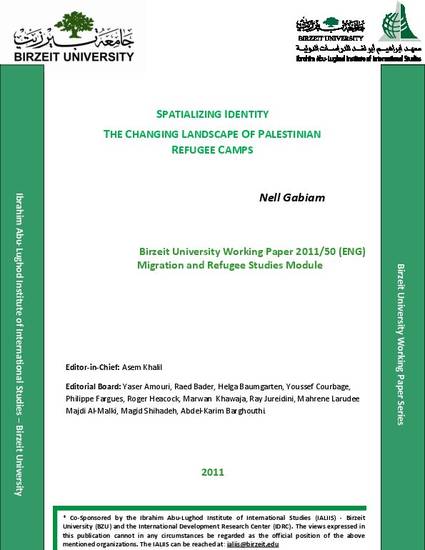
Unpublished Paper
Spatializing Identity: The Changing Landscape of Palestinian Refugee Camps
Birzeit University Working Paper Series
(2011)
Abstract
My paper addresses subtheme No. 2 of the conference: “The phenomenon found among some refugees of moving away from existing stereotypes, such as that of the victim, and its impact on successive generations.” In line with this subtheme, it explores changes in the way Palestinian refugees have understond their refugee identity by focussing on the landscape of the refugee camp. After more than sixty years of exile, Palestinian refugees have either stopped living in camps or have seen gradual changes affect the landscape of their camps. These changes were brought about by refugees themselves, by UNRWA (United Nations Relief and Works Agency for Palestine Refugees in the Near East) or by other outside interventions. Generally speaking, changes to the landscape of Palestinian refugee camps remain a sensitive issue and there are many examples in the past of Palestinian refugees resisting outside efforts to physically alter their camps. This is partly because historically, the landscape of the refugee camp has played an important role as a "witness" to the suffering their inhabitant have had to endure as a result of forced displacement. Another reason is the fear from refugees that such changes, often undertaken through outside interventions in the name of improving living conditions in the camp, might become a substitute to the right of return.
Focussing on the experiences of Palestinian refugees in Syria, I argue that with the passage of time, growing integration into the host-state, and policy shifts within UNRWA, the role of physical space of the refugee camp as a signifier of of Palestinian identity has diminished. Palestinian refugees living in camps are increasingly expressing their refugee identity in more flexible and abstract terms. This does not signify the demise of the camp as a particular kind of space for Palestinian refugees. Rather, Palestinian refugees are increasingly departing from a notion of "camp" that is firmly grounded in the physical landscape they inhabit and the material suffering this landscape is supposed to connotes.
My arguments are based on fieldwork carried out from 2004 to 2006 in Syria in the Palestinian refugee camps of Yarmouk, Neirab, and Ein el Tal. They engage especially with the UNRWA sponsored Neirab Rehabilitation Project taking place in the Palestinian refugee camps of Neirab and Ein el Tal. Characterized by UNRWA as a "development project" the Neirab Rehabilitation Project has sought to improve the infrastructure of both Neirab and Ein el Tal, improve the economic conditions of refugees, and encourage refugee activism around social and cultural issues. The debates and controversies surrounding UNRWA plans to raze the World War II era zinc-covered barracks that were at the origin of Neirab Camp and replace them with a more modern type of housing provide and especially insightful lens into understanding the shifts that have occured in the way Palestinian refugees relate to the space of the refugee camp.
Keywords
- Refugees,
- Landscape,
- Identity
Disciplines
Publication Date
2011
Citation Information
Nell Gabiam. "Spatializing Identity: The Changing Landscape of Palestinian Refugee Camps" Birzeit University Working Paper Series (2011) Available at: http://works.bepress.com/nell-gabiam/4/
